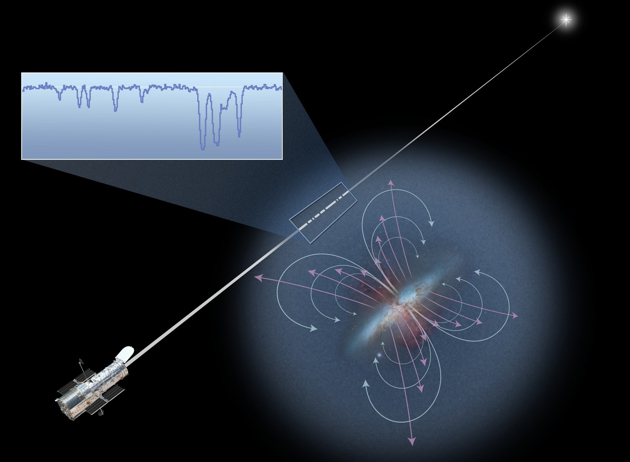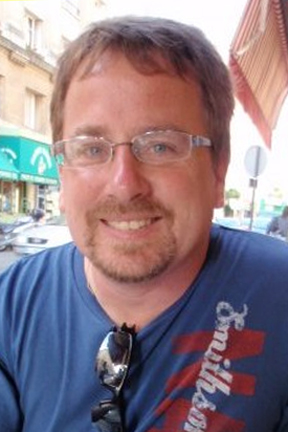NMSU astronomer leads international collaborative exploring galactic evolution


The flow of gas in outer space may hold the key to understanding how galaxies form and evolve, and why the Milky Way looks the way it does today. Astronomers at New Mexico State University will take the helm of NASA's Hubble Space Telescope in October for an international study into the evolution of galaxies.
"We will be using the observational data and comparing them to high powered cosmological simulations in which galaxies are modeled with very high resolution," said Chris Churchill, associate professor of astronomy in the College of Arts and Sciences and principal investigator for the project. "Our goals are to measure the detailed properties of the gas surrounding 50 different galaxies in order to determine how the gas flows around galaxies."
Churchill's group was recently awarded 110 90-minute observational orbits on Hubble from NASA and the Space Telescope Science Institute for the study that will include $350,000 in research funding. The project, "A Breakaway from Incremental Science: Full Characterization of the Circumgalactic Medium and Testing Galaxy Evolution Theory," is in collaboration with scientists in Australia, India, Spain and the Netherlands.
"We will use the instrument on Hubble called the Cosmic Origins Spectrograph, which records the spectrum in ultraviolet light," Churchill said. "Ultraviolet light cannot penetrate the Earth's atmosphere and this is why we need to use a telescope in space."
Gas plays a critical role in the creation of galaxies, according to Churchill. They form in regions where dark matter gravitationally collapses into large dense areas of the universe called halos. Normal matter, still in the form of gas, then gravitationally falls into the halos. The gas condenses, and then forms stars, which creates galaxies similar to the Milky Way, our galaxy.
"The interesting thing now is that it's not just about gas falling into these dark matter halos, but as stars age many of them turn into supernovae explosions, and they can actually be so violent they can blow gas back out into the media around the galaxy," Churchill said.
Churchill said what they don't know is how much gas goes through the process or why some stars die in the explosions. The team will address questions about outflowing gas, infalling gas and galactic fountains. They will also investigate how the gas cycle regulates the shape of the galaxy and the formation of future stars and planets.
"So we've come to understand that there's now a tenuous gaseous medium around galaxies that cycles," Churchill said. "So you have new stuff coming in, stuff cycling out, some might escape and some might rain back down. This is the process that a galaxy would then evolve."
He believes there are clear theoretical predictions as to what they should see in the telescope data.
"We will either see what is predicted by theory, confirming our current ideas about galaxy evolution, or we won't," Churchill said. "In which case, our data will challenge current theories and force us to think of new theories."
Churchill's NMSU team includes Anatoly Klypin, professor of astronomy, and graduate students Sebastian Trujillo-Gomez, Nigel Mathes, Nikki Nielsen and Jacob Vander Vliet. Amber Medina, physics major, will also lend a hand.
Jane Charlton, professor of astronomy at Penn State, serves as co-investigator with Churchill.
Collaborating on the project with them are Glenn Kacprzak, an Australian Research Council Super Science Fellow at the Swinburne University of Technology in Australia; Michael Murphy, an assistant professor at the Swinburne University of Technology in Australia; Anand Narayanan, an assistant professor at the Indian Institute of Space Science and Technology in India; Daniel Ceverino-Rodriguez, a postdoctoral student at the Universidad Autonoma de Madrid, Spain; and Freeke van de Voort, a joint fellow at the Theoretical Astrophysics Center at University of California, Berkeley and the Academia Sinica Institute of Astronomy and Astrophysics in Taipei, China.
The teams will work in three main research groups, managed by Churchill and Charlton.
Churchill, Charlton, Mathes and Arayanan will retrieve the spectra from the Space Telescope Science Institute, calibrate it and then measure the gas properties recorded in the data.
"The data reveals the gas properties through absorption features in the quasar spectra," Churchill said. "Each feature will be due to a different chemical element in the gas. After further analysis, we can obtain the chemical make-up of the gas, its density, temperature and its dynamical motions."
Klypin, Trujillo-Gomez, Vander Vliet, Ceverino-Rodriguez and van de Voort are involved with the theoretical interpretation of the telescope data. They will be running cosmological simulations on NASA super computers.
"In these simulations of the cosmos, galaxies form and can be studied at high resolution and in great detail," Churchill said. "The galaxies can be visualized in three dimensions. We then create synthetic telescope data of these simulated galaxies and study them to help interpret the real telescope data."
Kacprzak, Murphy and Nielsen will study the images and spectra of the galaxies to obtain information such as star formation rates, chemical enrichment levels, dark matter mass, rotation speeds and morphologies.
"These details allow us to compare the gas properties with the galaxy properties and compare them with theoretical predictions and expectations," Churchill said.
The Milky Way is more than 13 billion years old and recent Hubble Telescope studies have only covered nearby galaxies up to two billion years or 10 billion years and older, according to Churchill. He said this project provides a missing link in cosmic time.
"There's this huge gap from two to 10 billion years that was not being probed at all, and with all the data coming in from those, we felt it was really important to tie together that gap in time, so we could understand the actual evolution in time," Churchill said.
Telescope time is awarded through a highly competitive peer-review process, with a panel ranking the proposals before scrutinized by a special NASA committee.
"For this competition cycle, we succeeded in being awarded the requested telescope time to obtain data require to pursue our science goals," Churchill said. "It is difficult to quantify the probability of success, but it is a bit like feeling you won the big-time lottery."
Churchill's observations will be part of the telescope's Cycle 21, which runs from Oct. 1, 2013 through Sept. 30, 2014. He expects to receive the telescope schedule later this month, and the team will know down to the second when Hubble has their data. Once the data arrives, the scientists will begin to analyze.


